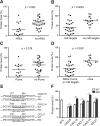Widespread Effects of Chemokine 3' Untranslated Regions on mRNA Degradation and Protein Production in Human Cells
- PMID: 29907706
- PMCID: PMC6057839
- DOI: 10.4049/jimmunol.1800114
Widespread Effects of Chemokine 3' Untranslated Regions on mRNA Degradation and Protein Production in Human Cells
Abstract
Chemokines are a large family of chemotactic cytokines that play critical roles in inflammation, development, and diseases. Chemokine expression is highly regulated during development and in response to environmental stimuli. The 3' untranslated regions (3'-UTRs) of mRNA are believed to be important in the control of chemokine gene expression. However, the regulatory effects of most chemokine 3'-UTRs have not been characterized previously. In this work, we systematically studied the effects of 43 CC and CXC chemokine 3'-UTRs on gene expression in eight human cell lines and two types of human primary cells. We found that chemokine 3'-UTRs had a wide spectrum of regulatory effects on mRNA abundance and protein production that were tightly correlated with the effects on mRNA stability. In general, 3'-UTRs had remarkably similar effects across all cell types studied. The presence of AU-rich elements, microRNA targets, and Pumilio binding sites were associated with chemokine 3'-UTR activity but did not fully account for all 3'-UTR activity detected using the reporter assay. Mutational analysis illustrated how specific cis-regulatory elements contributed to the regulatory effect of chemokine 3'-UTRs. These findings bring new insights into the mechanisms by which chemokine expression is regulated by 3'-UTRs.
Copyright © 2018 by The American Association of Immunologists, Inc.
Conflict of interest statement
The authors declare no competing financial interests.
Figures





Similar articles
-
CRISPR-Cas9-mediated functional dissection of 3'-UTRs.Nucleic Acids Res. 2017 Oct 13;45(18):10800-10810. doi: 10.1093/nar/gkx675. Nucleic Acids Res. 2017. PMID: 28985357 Free PMC article.
-
Toward a systematic understanding of mRNA 3' untranslated regions.Proc Am Thorac Soc. 2011 May;8(2):163-6. doi: 10.1513/pats.201007-054MS. Proc Am Thorac Soc. 2011. PMID: 21543795 Free PMC article.
-
Characterizing mRNA Sequence Motifs in the 3'-UTR Using GFP Reporter Constructs.Methods Mol Biol. 2018;1720:77-88. doi: 10.1007/978-1-4939-7540-2_6. Methods Mol Biol. 2018. PMID: 29236252
-
Translating the Untranslated Region.J Immunol. 2015 Oct 1;195(7):2963-71. doi: 10.4049/jimmunol.1500756. J Immunol. 2015. PMID: 26386038 Free PMC article. Review.
-
Implications of polyadenylation in health and disease.Nucleus. 2014;5(6):508-19. doi: 10.4161/nucl.36360. Epub 2014 Oct 31. Nucleus. 2014. PMID: 25484187 Free PMC article. Review.
Cited by
-
Post-Transcriptional Control of mRNA Metabolism and Protein Secretion: The Third Level of Regulation within the NF-κB System.Biomedicines. 2022 Aug 29;10(9):2108. doi: 10.3390/biomedicines10092108. Biomedicines. 2022. PMID: 36140209 Free PMC article. Review.
References
-
- Charo IF, Ransohoff RM. The many roles of chemokines and chemokine receptors in inflammation. The New England journal of medicine. 2006;354:610–621. - PubMed
-
- Moser B, Loetscher P. Lymphocyte traffic control by chemokines. Nature immunology. 2001;2:123–128. - PubMed
-
- Gerber BO, Zanni MP, Uguccioni M, Loetscher M, Mackay CR, Pichler WJ, Yawalkar N, Baggiolini M, Moser B. Functional expression of the eotaxin receptor CCR3 in T lymphocytes co-localizing with eosinophils. Current biology : CB. 1997;7:836–843. - PubMed
Publication types
MeSH terms
Substances
Grants and funding
LinkOut - more resources
Full Text Sources
Other Literature Sources

